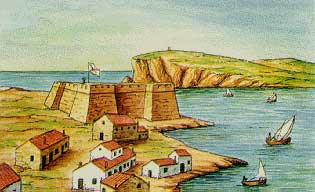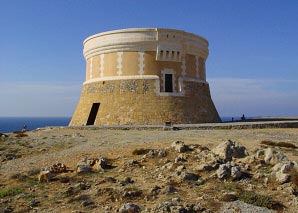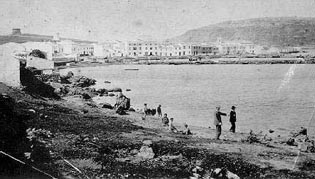Guide Baearics
Balearics Islands General
Demographics
The Balearics (Illes Balears in Catalan) consists the four main islands - Mallorca (aka Majorca in English), Menorca (Minorca), Ibiza and Formentera. Including all the islets, the islands have a combined area of 5040 sq km with 1,236 kilometres of coastline and a population of 869,213. Mallorca is by far the largest in area (3640 sq km) and population (700,804), more than half of which live in Palma.
The islands are invaded every summer by a massive multinational force of tourists. 12.7 million arrived by air in 2007 of which only a quarter were Spanish nationals. A further 1.7 million arrived by sea, either on scheduled ferries or Cruise ships. Some of the tourists are hedonistic party animals and sun-seekers, others are quiet family groups or serious walkers or cyclists. This is hardly surprising when you consider what's on offer - fine beaches, breathtaking scenery, remote timeless villages, relentless sunshine, good food and wine as well as wild nightlife.
What is surprising is that, despite this massive influx every summer have, to a degree, maintained their individuality and links with the past. Behind the bars and beaches are Gothic cathedrals, Stone Age ruins, fishing villages, spectacular walks, endless olive and almond groves and orange orchards. Tourism has far from consumed these islands except in a few localised areas where the locals are getting increasingly upset by the yearly influx of lager louts and cocaine-snorting clubbers.
The foreign invasion isn't just seasonal. A study released by the INE (Institute Nacional de Estadisticas, or National Institute of Statistics) in April 2010 shows that the Baleares have the highest percentage of foreign residents in all of Spain with a massive 22 per cent of their residents being non-Spaniards. This is 1.7 per cent more than in 2009 or, put more dramatically, 4,142 more non-nationals than this time last year. Of the 241,704 foreign residents on the islands, 35,934 are German, 23,815 are Moroccan, 23,433 are from the United Kingdom, 16,766 are originally from Italy, 12,581 are Romanian, and over 10,000 are registered as Columbian or Argentinean. Of course there are other groups but those stated above are those most widely represented in the Balearic Islands.
Compared to the mainland, this is a rather large increase, seeing as nationwide, Spain's foreign influx has dropped. Its foreign population only reaches 1.1 per cent of the national total (with some 5.7 million non-Spanish nationals). There are more foreign men registered than women, 52.5 per cent of incomers are male, although on the national average there are more Spanish born women than men at 51 per cent.
The influx has completely warped the local housing market. Farm cottages sell for figures that Spaniards wouldn't consider paying for decent flats in central Madrid or Barcelona. In fact, even Germans looking at real estate windows can be heard to mutter 'Wahnsinn!' ('madness!').
Still, even now stories abound of northern Europeans simply popping up in some inland Mallorcan village (forget the coast -you pay downtown Manhattan prices there) and asking around if anything is for sale. When told of the asking price, they simply double and pay in cash (the house back home may well be mortgaged to the hilt!). The trend cuts most Majorcans out of the running altogether.
The official language for all of Spain is Castellano (Spanish) but like the UK and other countries there are many local dialects and languages. Catalan and Malloquean being in wide use.
History
Archaeologists believe the first human settlements in the Balearic Islands date from around 5000 BC. An abundance of prehistoric relics and monuments uncovered on the islands show that these communities built houses of stone, practised basic agriculture, domesticated animals, performed ritual burials and manufactured pottery, tools and jewellery.
The Balearics were regular ports of call for ancient Phoenician traders. They were followed by the Carthaginians, who founded Ibiza City in 654 BC and made it one of the Mediterranean's major trading ports. Next came those compulsive road-builders the Romans, who, in turn, were conquered by the Visigoths. The Muslims, who invaded the islands in the 8th century, left a lasting legacy – you can see it in the appearance and customs of the local people, in their traditional and dress, and in much of the island's architecture.
Three centuries of Muslim domination ended with the Christian Reconquista by Jaume I of Catalunya and Arag6n, who took Palma de Mallorca in 1229 and sponsored the invasion of Ibiza in 1235. Menorca was the last to fall: Alfonso III took it in 1287 in a nasty campaign, completing the islands' incorporation into the Catalan world.
After the initial boom as trading centres and Catalan colonies, the islands had fallen on hard times by the 15th century. Isolation from the mainland, famines and frequent raids by pirates contributed to their decline. During the 16th century, Menorca's two major towns were virtually destroyed by Turkish forces and Ibiza City's fortified walls were built. After a succession of bloody raids, Formentera was abandoned
The Balearics fared poorly in warfare. After backing the Habsburgs in the Spanish War of Succession, Mallorca and Ibiza were occupied by the victorious Bourbon monarchy in 1715. Menorca, on the other hand, was granted to the British along with Gibraltar in 1713 under the Treaty of Utrecht. British rule lasted until 1802, with the exception of the Seven Years War (1756-63), during which the French moved in.
Brief moments of recovery subsequently proved illusory and the rot was only stopped by the advent of mass tourism in the 1950s. The islands now enjoy - by some estimates - the highest standard of living in Spain. This has proven something of a double-edged sword. The quick euro is king; construction and hotel mafias have made a killing on the costas while farming and most other pillars of the economy have fallen by the wayside. And when the tourists stay away, as they did in part in 2002, anxiety grips the islanders — or at least the local press.
Mallorca
 Mallorca demograpics
Mallorca demograpics
Ibiza
Demographics
Ibiza (Eivissa in Catalan) is third in size with an area of 541 sq km and 210 km of coastline.


